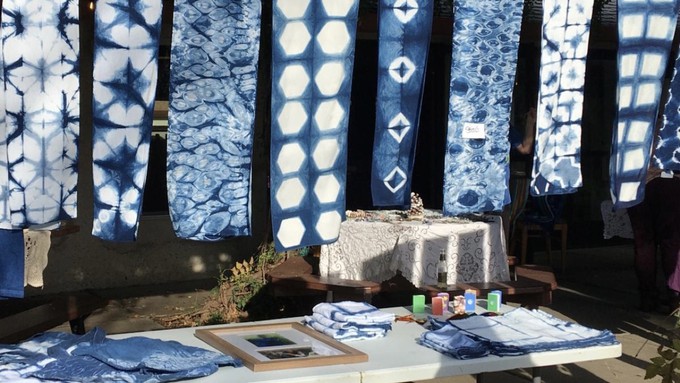
Find great bargains on art and craft supplies, and learn to tie-dye naturally

The inaugural Community Indigo Dip Dye Day will be held Saturday at the Shepard Center. Photo courtesy Sacramento Center for Textile Arts
It’s time to get the blues – and “art elephants,” too.
Saturday, June 24, the Sacramento Center for Textile Arts presents two simultaneous events in one place: Its annual “Art Elephant Sale” and its first Community Indigo Dip Dye Day.
Both events will take place at Shepard Garden and Arts Center in McKinley Park. Admission to the sale is free; advance registration ($15) is required for the Indigo Dip and you'd better hurry. Only a few slots are still available.
What is an “art elephant”? It's an inspirational treasure that, like a white elephant, just needs someone who knows what to do with it. It’s also a chance for members to clean out their studios and closets of excess supplies.
Find great deals on all sorts of materials including fabrics, textiles, fibers, beads and art supplies. (Expect lots of miscellaneous crafts supplies, too.) Sale hours are 10 a.m to 3 p.m. Saturday.
Meanwhile on the patio, watch how to dye fabric with natural indigo dyes. Indigo Shibori dye experts LuAnne Hansen, Tanya Lieberman, and Joan McMurray will lead one-hour hands-on workshops on indigo – blue jean blue, the color that unites the world. This is the center’s inaugural indigo dye day and serves as an introduction to both natural dyeing and the group.
The workshop includes all materials; participants can choose from a cotton bandana or a “fat quarter” of cotton fabric that can be sewn into another item. During the workshop, participants also will learn how to tie-dye to produce unique patterns. Remember: Indigo is a permanent dye. Participants should wear old clothes and shoes or bring protective covering such as an apron.
Shepard Garden and Arts Center is located at 3330 McKinley Blvd., Sacramento.
Details and workshop registration: https://sactextilearts.org/.
Comments
0 comments have been posted.Sacramento Digs Gardening to your inbox.
Sites We Like
Garden Checklist for week of July 21
Your garden needs you!
* Keep your vegetable garden watered, mulched and weeded. Water before 8 a.m. to reduce the chance of fungal infection and to conserve moisture.
* Feed vegetable plants bone meal, rock phosphate or other fertilizers high in phosphate to stimulate more blooms and fruiting. (But wait until daily high temperatures drop out of the 100s.)
* Don’t let tomatoes wilt or dry out completely. Give tomatoes a deep watering two to three times a week.
* Harvest vegetables promptly to encourage plants to produce more. Squash especially tends to grow rapidly in hot weather. Keep an eye on zucchini.
* Pinch back chrysanthemums for bushy plants and more flowers in September.
* Remove spent flowers from roses, daylilies and other bloomers as they finish flowering.
* Pinch off blooms from basil so the plant will grow more leaves.
* Cut back lavender after flowering to promote a second bloom.
* It's not too late to add a splash of color. Plant petunias, snapdragons, zinnias and marigolds.
* From seed, plant corn, pumpkins, radishes, winter squash and sunflowers.